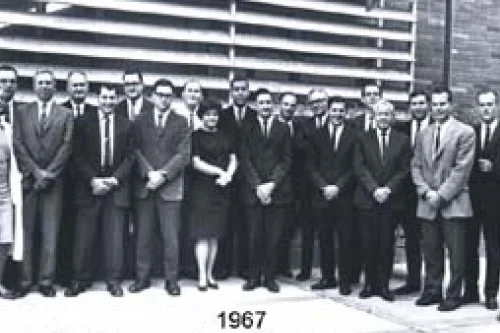About

Evolution of the Department
- 1951-1989: Anatomy Department
- 1989-1995: Anatomy & Cell Biology
- 1995- Present: Neurobiology
Yesterday: A Department of Pioneers
The Department of Neurobiology in the David Geffen School of Medicine at UCLA is the new incarnation of the Department of Anatomy, one of the first departments of the UCLA School of Medicine, founded in 1955. Since that time, the faculty members have initiated entirely new fields of research and made discoveries that have changed the way we think about the brain. For example, Dr. Charles H. Sawyer and Dr. Roger Gorski, both former Chairs of the Department, were pioneers of neuroendocrinology, which is the study of reciprocal interactions between hormones and the brain. Dr. Edwin Cooper pioneered the field of Comparative Immunology. Drs. Young and Dean Bok made fundamental discoveries in vision. Dr. Lawrence Kruger performed pioneering studies on pain mechanisms. Dr. Arnold Scheibel was one of the first investigators to describe anatomical alterations in the brains of schizophrenics, thus confirming that mental illness has a biological basis in the architecture of the brain.
Today: A Sustained tradition of excellence and innovation
Researchers in the Department of Neurobiology continue to make breakthrough discoveries in understanding the fundamental workings of how the brain is ‘wired’, sees, tells time, learns and remembers. Investigators are plumbing our understanding of the importance of sleep, social interactions and how the brain develops and recovers from injury.
Tomorrow: A continuing commitment to improving our knowledge of the Nervous System
According to Dr. Elias Zerhouni, former Director of the National Institutes of Health, in an article in Science magazine (2006, 314:1088-1090), “There is an urgent need to transform health and medicine from the curative and onerous paradigm of today to the vision of a more predictive, personalized and preemptive world of healthcare. The only hope to do so is to further our understanding of biology and behavior through sustained scientific discover.”
This is the mission of the Department of Neurobiology at UCLA. Building on a strong tradition and continuing efforts to understand how the nervous system functions and responds to our environment, the faculty are poised to make key contributions to the knowledge that will transform medicine in the future.
History
The MD program at the University of Washington had been in existence for only a couple of years when Dr. Horace "Ted" Magoun, an internationally well-known neuroanatomist at Northwestern, visited the UW Anatomy Department on his way to plan and organize the Anatomy Department at UCLA. My wife, Bergliot, who was working at UW as a research technician, encountered "Ted" in the hall and responded to his inquiries about me. I had TA'd in his Anatomy Department at Northwestern where he had become aware of my interests and research. Soon after, I received a letter from him asking if I would be interested in joining the Anatomy Department about to emerge at UCLA. I replied, "Sure!"
When my internship finished on June 31, 1951, Bergliot and I were on our way to UCLA. We stayed with the Magouns for a few days until finding an apartment. Tom and Ruth Sawyer arrived a couple of months later. In 1951, Tom delivered the first of any medical school lecture to that class of ~20 students. For the next four years, I was knee deep in lecturing and cadavers in what had been a Religious Conference Building, when the first medical school building was born, into which Gross Anatomy was moved, along with each of our research labs.
Horace W. Magoun was the driving force behind the creation of the Brain Research Institute (BRI) on the UCLA campus in 1959. Twice nominated for the Nobel Prize, Magoun is widely regarded as one of the founding fathers of neuroscience both for his research endeavors and his then radical administrative strategies uniting the major divisions of neural, behavioral and communicative studies under one central banner.